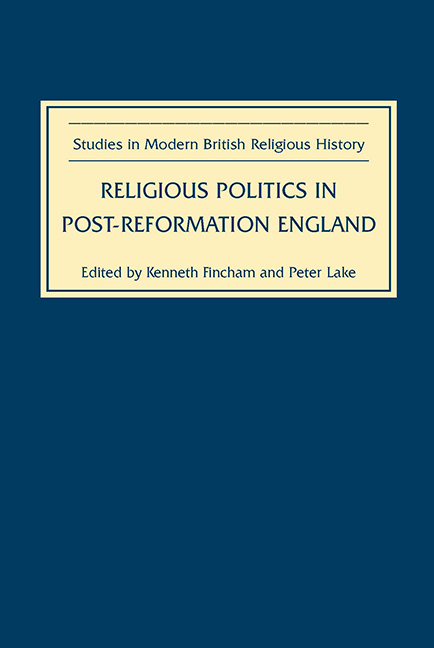Book contents
- Frontmatter
- CONTENTS
- Dedicaton
- Miscellaneous Frontmatter
- Preface
- Abbreviations
- 1 Introduction: Puritanism, Arminianism and Nicholas Tyacke
- 2 Art and Iconoclasm in Early Modern England
- 3 The Latitude of the Church of England
- 4 Joan of Contention: The Myth of the Female Pope in Early Modern England
- 5 Anti-Puritanism: The Structure of a Prejudice
- 6 The Fortunes of English Puritanism: An Elizabethan Perspective
- 7 What's in a Name? Dudley Fenner and the Peculiarities of Puritan Nomenclature
- 8 Puritan Preachers and their Patrons
- 9 New England's Reformation: ‘Wee shall be as a Citty upon a Hill, the Eies of All People are upon Us’
- 10 ‘Anglicanism’ by Stealth: The Career and Influence of John Overall
- 11 Destroyed for doing my Duty: Thomas Felton and the Penal Laws under Elizabeth and James I
- 12 Charles I and Providence
- 13 John Shawe and Edward Bowles: Civic Preachers at Peace and War
- 14 Material Evidence: The Religious Legacy of the Interregnum at St George Tombland, Norwich
- Index
- Tabula Gratulatoria
- Studies in Modern British Religious History
3 - The Latitude of the Church of England
Published online by Cambridge University Press: 25 October 2017
- Frontmatter
- CONTENTS
- Dedicaton
- Miscellaneous Frontmatter
- Preface
- Abbreviations
- 1 Introduction: Puritanism, Arminianism and Nicholas Tyacke
- 2 Art and Iconoclasm in Early Modern England
- 3 The Latitude of the Church of England
- 4 Joan of Contention: The Myth of the Female Pope in Early Modern England
- 5 Anti-Puritanism: The Structure of a Prejudice
- 6 The Fortunes of English Puritanism: An Elizabethan Perspective
- 7 What's in a Name? Dudley Fenner and the Peculiarities of Puritan Nomenclature
- 8 Puritan Preachers and their Patrons
- 9 New England's Reformation: ‘Wee shall be as a Citty upon a Hill, the Eies of All People are upon Us’
- 10 ‘Anglicanism’ by Stealth: The Career and Influence of John Overall
- 11 Destroyed for doing my Duty: Thomas Felton and the Penal Laws under Elizabeth and James I
- 12 Charles I and Providence
- 13 John Shawe and Edward Bowles: Civic Preachers at Peace and War
- 14 Material Evidence: The Religious Legacy of the Interregnum at St George Tombland, Norwich
- Index
- Tabula Gratulatoria
- Studies in Modern British Religious History
Summary
My title has a useful ambiguity, reflecting the two tasks that I seek to carry out. One is to continue my efforts to place the pre-Restoration Church of England in its theological latitude in protestant Europe up to the late seventeenth century. The other is to note just how much latitude was possible within this structure, and to consider why that might be. On the first point, the historiography has been complicated by the battles of church parties that started in the seventeenth century, the aim of which was very precisely to shift the latitude of the Church of England. Sometimes the aim has been to tow the Church firmly into the latitude of sixteenth-century Geneva or seventeenth-century Boston: still avowedly the agenda of Peter Jensen, the present Anglican archbishop of Sydney. Sometimes the ship has been tugged into the Tiber and moored against the Trastevere bank within sight of the Vatican. A more generally popular course has been to head for a theological Bermuda Triangle and label the location ‘Anglicanism’, well out of reach of any foreign pollution and not susceptible to ready identification with any other ‘ism’. The implication of this is that Anglicanism is sui generis, and that in some mysterious or mystical way this was the intention of the Tudor monarchs, churchmen and statesmen who founded it in the first place.
This Anglican latitude certainly does represent something essential and undeniable about the modern Church of England and its sister-churches of Wales, Scotland and Ireland and their worldwide offshoots; but the Anglican identity is extremely problematic if applied to the pre-1662 Church of England. I have consistently discouraged students from using the word at all in that earlier context, though I still constantly notice the usage in places distressingly beyond my influence or control. It cannot be emphasized too often that the Anglican word is comparatively recent as a usage. It may well have been invented by James VI of Scotland, and if so, it was meant as a term of abuse: in 1598, he assured a suspicious Church of Scotland that his proposed strengthening of episcopacy would not take Scotland down a path to ‘papistical or Anglican’ bishops.
- Type
- Chapter
- Information
- Religious Politics in Post-Reformation England , pp. 41 - 59Publisher: Boydell & BrewerPrint publication year: 2006

